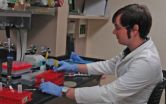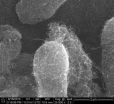(Press-News.org) Today, the body of an ordinary family car consists of 193 different types of steel. The steel for each part of the car has been carefully selected and optimised. It is important, for example, that all parts are as light as possible because of the fuel consumption, whereas other parts of the car have to be super strong in order to protect passengers in a collision.
Super strong nanostructured metals are now entering the scene, aimed at making cars even lighter, enabling them to stand collisions in a better way without fatal consequences for the passengers. Research into this field is being conducted worldwide. Recently, a young PhD student from the Materials Research Division at Risø DTU took research a step further by discovering a new phenomenon. The new discovery could speed up the practical application of strong nanometals and has been published in the highly esteemed journal "Proceedings of the Royal Society" in London in the form of a paper of approx. 30 pages written by three authors from Risø DTU.
The research task of the young student, Tianbo Yu, is to determine the stability in new nanostructured metals, which are indeed very strong, but also tend to become softer, even at low temperatures. This is due to the fact that microscopic metal grains of nanostructured metals are not stable - a problem of which Tianbo Yu's discovery now provides an explanation.
The fine structure consists of many small metal grains. The boundaries between these metal grains can move, also at room temperature. At the same time a coarsening of the structure takes place and the strength of the nanometal is consequently weakened. Tianbo Yu's has now shown that the boundaries of the grains can be locked, when small particles are present and that the solution is technologically feasible. This has paved the way for car components to be made of nanometals.
"We are cooperating with a Danish company and also a Danish consulting engineering company with the purpose of developing light and strong aluminium materials with a view to their application in light vehicles where especially deformation at high rate as in a collision is in focus. The new findings will be included in this work," says Dorte Juul Jensen, head of division and Dr. Techn. She is happy that the excellent findings also have practical applications.
Tianbo Yu comes from Tsinghua University in Beijing – a leading university within technical scientific research. His studies in Denmark have been financed by the Danish National Research Foundation, which also supports a Danish-Chinese basic research centre in the Materials Research Division, where Tianbo Yu is now employed.
Tianbo Yu is a dedicated and talented researcher, who wishes to pursue a research career in Denmark. His wife is a student at RU (Roskilde University) and along with their studies, they both have decided to put a lot of effort into learning Danish; and they have become good at it. – All in all, a success for science as well as globalisation.
Smaller metal grains result in stronger metals
Nanometals contain very small metal grains - from 10 to 1,000 nanometers. One nanometer is a millionth of a millimetre. The smaller the metal grains become, the stronger the metal becomes. The metal becomes twice as strong, for example, if the individual metal grains are made four times smaller. That is why the materials scientists work to reduce the size of the individual metal grains. In steel and aluminium, the particles have been reduced to below 1 micrometre, which is one thousandth of a millimetre. There is a great interest in nanometals worldwide. Nanometals are super strong and their super strength can be combined with other desired properties, too.
A good example of a super strong nanometal is the thin steel wires used in grand pianos and for strengthening lorry tyres and containers, which have to withstand an extremely high pressure. Actually, they have been known for many years, but now they have become the subject of scientists' renewed and strong interest.
Scientists are not only interested in the size of the metal grains. The interfaces between the individual metal grains are also important to a number of properties. A special type of grain boundaries, so-called twin boundaries, provides both strength and good electrical conductivity. This paves the way for producing thinner wires, thereby reducing material consumption.
### END
A new discovery paves the way for using super strong nanostructured metals in cars
2011-07-22
ELSE PRESS RELEASES FROM THIS DATE:
University of Leicester develops test for classifying force used in bottle stabbings
2011-07-22
Engineers at the University of Leicester have for the first time created a way of measuring how much force is used during a stabbing using a broken bottle. The advance is expected to have significant implications for legal forensics.
A team from the University has conducted a systematic study of the force applied during a stabbing and come up with the first set of penetration force data for broken glass bottles. This work has been published in the International Journal of Legal Medicine (http://www.springerlink.com/content/v21t5g05250n22xw/)
Stabbing is the most ...
Study suggests obesity accelerates progression of cirrhosis
2011-07-22
Researchers from the United States and Europe involved in an NIH-funded multicenter study have determined that increased body mass index (BMI) is an independent predictor of clinical decompensation in patients with compensated cirrhosis, independent of portal pressure and liver function. The findings suggest obesity accelerates cirrhosis progression and measures to reduce BMI could improve the prognosis for patients with advanced liver disease. Study details are available in the August issue of Hepatology, a journal published by Wiley-Blackwell on behalf of the American ...
Metabolic syndrome increases risk of both major types of primary liver cancer
2011-07-22
Incidence rates of hepatocellular carcinoma (HCC) and intrahepatic cholangiocarcinoma (ICC) have increased in the U.S. This population-based study publishing in the August issue of Hepatology, a journal of the American Association for the Study of Liver Diseases, found that metabolic syndrome significantly increases risk of developing these primary liver cancers.
According to data from the National Cancer Institute, 24,120 new cases of liver and intrahepatic bile duct cancer and close to 19,000 deaths from the diseases occurred in the U.S. in 2010. Major risk factors ...
Software helps synthetic biologists customize protein production
2011-07-22
A software program developed by a Penn State synthetic biologist could provide biotechnology companies with genetic plans to help them turn bacteria into molecular factories, capable of producing everything from biofuels to medicine.
"It's similar to how an engineer designs a plane or a car," said Howard M. Salis, assistant professor in agricultural and biological engineering, and chemical engineering. "When designing a biological organism, there are many combinations that the engineer must test to find the best combination. This technology allows us to quickly identify ...
Scavenger cells accomplices to viruses
2011-07-22
This release is available in German.
VIDEO:
Red-colored adenovirus particles are found in the periphery of a human epithelial cell and steadily move towards the cell nucleus at the bottom of the image. The endocytic vesicles in...
Click here for more information.
Mucosal epithelia do not have any receptors on the outer membrane for the absorption of viruses like hepatitis C, herpes, ...
Bacterial attack strategy uses special delivery of toxic proteins
2011-07-22
When competing for food and resources, bacteria employ elaborate strategies to keep rival cells at bay. Scientists have now identified a pathway that allows disease-causing bacteria to attack other bacterial cells by breaking down their cell wall.
Pseudomonas aeruginosa is a type of bacteria readily found in everyday environments. It easily forms colonies in a wide variety of settings, including medical devices, body organs and skin wounds. This allows it to cause disease and act as a major pathogen, particularly in hospitals.
Research led by Joseph Mougous, assistant ...
Blue collar workers work longer and in worse health than their white collar bosses
2011-07-22
While more Americans are working past age 65 by choice, a growing segment of the population must continue to work well into their sixties out of financial necessity. Research conducted by the Columbia University's Mailman School of Public Health and the University of Miami Miller School of Medicine looked at aging, social class and labor force participation rates to illustrate the challenges that lower income workers face in the global marketplace. The study used the burden of arthritis to examine these connections because 49 million U.S. adults have arthritis, and 21 ...
Chronic pain in homeless people not managed well: Study
2011-07-22
TORONTO, Ont., July 21, 2011—Chronic pain is not managed well in the general population and it's an even greater challenge for homeless people, according to new research by St. Michael's Hospital.
Twenty-five per cent of Canadians say they have continuous or intermittent chronic pain lasting six months or more. The number is likely to be even higher among homeless people, in part due to frequent injuries.
Of the 152 residents of homeless shelters with chronic pain studied by Dr. Stephen Hwang, more than one-third (37 per cent) had Chronic Pain Grade IV, the highest ...
Nanotechnology for water filter
2011-07-22
This release is available in German.
Nanotechnology has developed tremendously in the past decade and was able to create many new materials with a vast range of potential applications. Carbon nanotubes are an example of these new materials and consist of cylindrical molecules of carbon with diameters of a few nanometers – one nanometer is one millionth of a millimeter. Carbon nanotubes possess exceptional electronic, mechanical and chemical properties, for example they can be used to clean polluted water. Scientists of the University of Vienna had recently published ...
Fingerprinting fugitive dust
2011-07-22
This release is available in Spanish.
Each community of soil microbes has a unique fingerprint that can potentially be used to track soil back to its source, right down to whether it came from dust from a rural road or from a farm field, according to a U.S. Department of Agriculture (USDA) soil scientist.
Ann Kennedy, at the Agricultural Research Service (ARS) Land Management and Water Conservation Research Unit in Pullman, Wash., studies the biological properties of soils that affect wind erosion. She analyses the soil for the fatty acid or lipid content from the community ...


